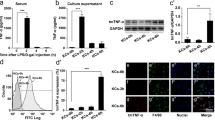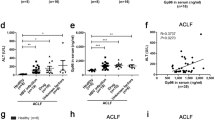Abstract
Purpose
It was reported from this laboratory that Kupffer cells (KCs) were activated in patients infected with HCV. Since dendritic cells, monocytes, and macrophages were activated by stimulation with HCV-related proteins, the specific aim of this study was to investigate the role of HCV-related proteins in activation of KCs, the signal pathway of activation of KCs mediated by Toll-like receptor (TLR) 4, and the influence of HCV infection on function of KCs.
Methods
Kupffer cells isolated from non-cancerous surgical specimen were co-cultured with HCV-related proteins (Core, NS3, NS4, and NS5), and production of cytokines (TNF-α, IL-1β, and IL-10) and hydrogen peroxide were assessed. Furthermore, effects of neutralization antibodies against the TLR2, TLR3, or TLR4, and cytochalasin B on the production TNF-α by KCs were investigated.
Results
Kupffer cells produced markedly a proinflammatory cytokine TNF-α by stimulation with all HCV-related proteins studied, and values were as same as production by KCs stimulated with LPS. Importantly, this production in the case of NS3 was significantly blunted by about 60% by neutralization antibodies against the TLR4, but not cytochalasin B. Production of TNF-α by isolated KCs stimulated with LPS was significantly greater in the HCV-infected livers than the HCV/HBV-negative livers.
Conclusions
These results indicated that HCV-related proteins may cause prolonged activation of KCs in the HCV-infected liver, leading to accumulation of inflammatory cytokines that contribute to DNA damage and carcinogenesis. Furthermore, function of KCs was difference between patients infected with and without HCV infection.





Similar content being viewed by others
Abbreviations
- DMSO:
-
Dimethyl sulfoxide
- ELISA:
-
Enzyme-linked immunosorbent assay
- HCC:
-
Hepatocellular carcinoma
- HCV:
-
Hepatitis C virus
- ICAM-1:
-
Intercellular adhesion molecule-1
- IL:
-
Interleukin
- KC:
-
Kupffer cell
- LPS:
-
Lipopolysaccharide
- MIP:
-
Macrophage inflammatory protein
- NS3:
-
Nonstructural 3 protein
- NS4:
-
Nonstructural 4 protein
- NS5:
-
Nonstructural 5 protein
- t-BOOH:
-
t-Butyl hydroperoxide
- TLR:
-
Toll-like receptor
- TNF:
-
Tumor necrosis factor
References
Kiyosawa K, Tanaka E. Characteristics of hepatocellular carcinoma in Japan. Oncology. 2002;62(1):5–7.
Yoshizawa H. Hepatocellular carcinoma associated with hepatitis C Virus infection in Japan: projection to other countries in the foreseeable future. Oncology. 2002;62(Suppl 1):8–17.
Tanaka Y, Hanada K, Mizokami M, et al. Inaugural article: a comparison of the molecular clock of hepatitis C virus in the United States and Japan predicts that hepatocellular carcinoma incidence in the United States will increase over the next two decades. Proc Natl Acad Sci USA. 2002;99:15584–15589.
McGuinness PH, Painter D, Davies S, McCaughan GW. Increases in intrahepatic CD68 positive cells, MAC387 positive cells, and proinflammatory cytokines (particularly interleukin 18) in chronic hepatitis C infection. Gut. 2000;46:260–269.
Maki A, Kono H, Gupta M, et al. Predictive power of biomarkers of oxidative stress and inflammation in patients with hepatitis C virus-associated hepatocellular carcinoma. Ann Surg Oncol. 2007;14:1182–1190.
Matsumoto K, Satoh Y, Sugo H, et al. Immunohistochemical study of the relationship between 8-hydroxy-2′-deoxyguanosine levels in noncancerous region and postoperative recurrence of hepatocellular carcinoma in remnant liver. Hepatol Res. 2003;25:435–441.
Burgio VL, Ballardini G, Artini M, Caratozzolo M, Bianchi FB, Levrero M. Expression of co-stimulatory molecules by Kupffer cells in chronic hepatitis of hepatitis C virus stiology. Hepatology. 1998;27:1600–1606.
Wheeler MD, Kono H, Yin M, et al. The role of Kupffer cell oxidant production in early ethanol-induced liver disease. Free Radic Biol Med. 2001;31:1544–1549.
Rusyn I, Kadiiska MB, Dikalova A, et al. Phthalates rapidly increase production of reactive oxygen species in vivo: role of Kupffer cells. Mol Pharmacol. 2001;59:744–750.
Dolganiuc A, Oak S, Kodys K, et al. Hepatitis C core and nonstructural 3 proteins trigger toll-like receptor 2-mediated pathways and inflammatory activation. Gastroenterology. 2004;127:1513–1524.
Dolganiuc A, Kodys K, Kopasz A, et al. Hepatitis C virus core and nonstructural protein 3 proteins induce pro-and anti-inflammatory cytokines and inhibit dendritic cell differentiation. J Immunol. 2003;170:5615–5624.
Chang S, Dolganiuc A, Szabo G. Toll-like receptors 1 and 6 are involved in TLR2-mediated macrophage activation by hepatitis C virus core and NS3 proteins. J Leukoc Biol. 2007;82:479–487.
Heuff G, Meyer S, Beelen RHJ. Isolation of rat and human Kupffer cells by a modified enzymatic assay. J Immunol Meth. 1994;174:61–65.
Decker K. Biologically active products of stimulated liver macrophages (Kupffer cells). Eur J Biochem. 1990;192:245–261. Review.
Pileri P, Uematsu Y, Campagnoli S, et al. Binding of hepatitis C virus to CD81. Science. 1998;282:938–941.
Zeisel MB, Koutsoudakis G, Schnober EK, et al. Scavenger receptor class B type I is a key host factor for hepatitis C virus infection required for an entry step closely linked to CD81. Hepatology. 2007;46:1722–1731.
Muriel P, Alba N, Perez-Alvarez VM, Shibayama M, Tsutsumi VK. Kupffer cells inhibition prevents hepatic lipid peroxidation and damage induced by carbon tetrachloride. Comp Biochem Physiol C Toxicol Pharmacol. 2001;130:219–226.
Niemela O, Parkkila S, Bradford B, Iimuro Y, Pasanen M, Thurman RG. Effect of Kupffer cell inactivation on ethanol-induced protein adducts in the liver. Free Radic Biol Med. 2002;33:350–355.
Michael SL, Pumford NR, Mayeux PR, Niesman MR, Hinson JA. Pretreatment of mice with macrophage inactivators decreases acetaminophen hepatotoxicity and the formation of reactive oxygen and nitrogen species. Hepatology. 1999;30:186–195.
Ju C, Reilly TP, Bourdi M, et al. Protective role of Kupffer cells in acetaminophen-induced hepatic injury in mice. Chem Res Toxicol. 2002;15:1504–1513.
Schwabe RF, Brenner DA. Mechanisms of liver injury. I. TNF-alpha-induced liver injury: role of IKK, JNK, and ROS pathways. Am J Physiol Gastrointest Liver Physiol. 2006;290:583–589.
Kamata H, Honda S, Maeda S, Chang L, Hirata H, Karin M. Reactive oxygen species promote TNFα-induced death and sustained JNK activation by inhibiting MAP kinase phosphatases. Cell. 2005;120:649–661.
Pham CG, Bubici C, Zazzeroni F, et al. Ferritin heavy chain upregulation by NF-kappaB inhibits TNFalpha-induced apoptosis by suppressing reactive oxygen species. Cell. 2004;119:529.
Asakawa M, Kono H, Amemiya H, et al. Role of interleukin-18 and its receptor in hepatocellular carcinoma associated with hepatitis C virus infection. Int J Cancer. 2006;118:564–570.
Zhang H-Y, Nanji AA, Luk JM, et al. Macrophage migration inhibitory factor expression correlates with inflammatory changes in human chronic hepatitis B infection. Liver Int. 2005;25:571–579.
Kallinowski B, Haseroth K, Marinos G, et al. Induction of tumour necrosis factor (TNF) receptor type p55 and p75 in patients with chronic hepatitis C virus (HCV) infection. Clin Exp Immunol. 1998;111:269–277.
Farinati F, Cardin R, Bortolami M, Guido M, Rugge M. Oxidative damage, pro-inflammatory cytokines, TGF-alpha and c-myc in chronic HCV-related hepatitis and cirrhosis. World J Gastroenterol. 2006;12:2065–2069.
Tomita M, Yamamoto K, Kobashi H, Ohmoto M, Tsuji T. Immunohistochemical phenotyping of liver macrophages in normal and diseased human liver. Hepatology. 1994;20:317–325.
Dolganiuc A, Garcia C, Kodys K, Szabo G. Distinct Toll-like receptor expression in monocytes and T-cells in chronic HCV infection. World J Gastroenterol. 2006;12:1198–1204.
Lin RS, Lee FY, Lee SD, et al. Endotoxemia in patients with chronic liver diseases: relationship to severity of liver diseases, presence of esophageal varices, and hyperdynamic circulation. J Hepatol. 1995;22:165–172.
Plachouras D, Stamatakos M, Baziaka F, et al. Portal and systemic endotoxemia in abdominal operations: the significance of acute abdomen. J Surg Res. 2006;134:133–137.
Author information
Authors and Affiliations
Corresponding author
Rights and permissions
About this article
Cite this article
Hosomura, N., Kono, H., Tsuchiya, M. et al. HCV-Related Proteins Activate Kupffer Cells Isolated from Human Liver Tissues. Dig Dis Sci 56, 1057–1064 (2011). https://doi.org/10.1007/s10620-010-1395-y
Received:
Accepted:
Published:
Issue Date:
DOI: https://doi.org/10.1007/s10620-010-1395-y




